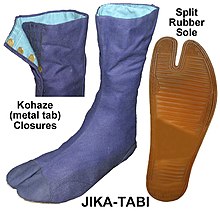From Wikipedia, the free encyclopedia
| This article does not cite any references or sources. Please help improve this article by adding citations to reliable sources. Unsourced material may be challenged and removed. (November 2007) |
Also known (outside Japan) as "tabi boots", they are modelled on tabi, traditional split-toe Japanese socks. Like other tabi, jika-tabi have a divided toe area so that they can in theory be worn with slip-on thonged footwear, but they are heavy-duty, and resemble boots.
Tokujirō Ishibashi, a brother of Shōjirō Ishibashi who is the founder of the major tire company Bridgestone Corporation, is credited with their invention.
One disadvantage of jika-tabi is that they provide no real protection to the foot against falling objects or protruding sharp objects.
In Japan
Being made of heavy, tough material and often having rubber soles, jika-tabi are often used by construction workers, farmers and gardeners, rickshaw-pullers, and other workmen.Though slowly being replaced by steel-toed, rigid-sole shoes in some industries, many workers prefer them for the softness of their soles. This gives wearers tactile contact with the ground, and the concomitant gripping ability lets them use their feet more agilely than rigid-soled shoes allow. This is useful for workers who traverse girders on construction sites and need to be sure what is under their feet. Carpenters and gardeners wearing these boots can, if they wish, use their feet as an extra pair of hands, for example to hold objects in place. There is also a line of knee-high all-rubber jika-tabi that is used by workers in rice fields and/or wet and muddy environments.
In more recent years, jika-tabi manufacturers, like Marugo and Rikio have introduced the "steel toe" and "hard resin" versions which are approved by the Japan Occupational Safety and Health Resource Center (JOSHRC).
In other countries
Outside Japan, where they are available from online and martial-arts shops, jika-tabi are appreciated by practitioners of martial arts in which traditional clothes are used. Other people also like wearing them for certain kinds of exercise, specifically trail-running, walking, and climbing.'Jika-tabi' footwear becomes the rage to walk like a Japanese
2012/05/24
 Sandal-type jika-tabi (Erina Ito)
Sandal-type jika-tabi (Erina Ito) Jika-tabi that can be fit to the feet with hook-and-loop fasteners (Erina Ito)
Jika-tabi that can be fit to the feet with hook-and-loop fasteners (Erina Ito) A French woman and her husband look at jika-tabi in the "Sou Sou Tabi" shop. (Erina Ito)
A French woman and her husband look at jika-tabi in the "Sou Sou Tabi" shop. (Erina Ito) A variety of tabi socks (Erina Ito)
A variety of tabi socks (Erina Ito) A lining of a jika-tabi shoe is shown. (Erina Ito)
A lining of a jika-tabi shoe is shown. (Erina Ito) The external appearance of Sou Sou Tabi shop (Erina Ito)
The external appearance of Sou Sou Tabi shop (Erina Ito)
KYOTO -- It's becoming comfortable and stylish to "walk like a
Japanese," in traditional "jika-tabi" split-toe footwear that has long
given much-needed traction and comfort to construction workers and
miners.

沒有留言:
張貼留言